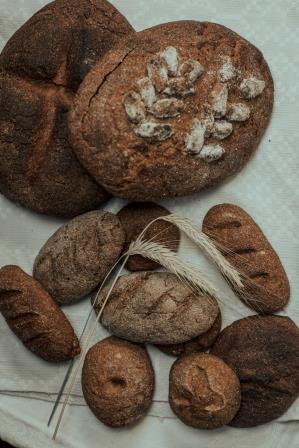
In the Estonian language, we usually translate the English word “bread” as “leib”. What we mean by “leib” is a loaf made primarily using rye flour. It might be whole-grain or refined, the loaves might have seeds or herbs, meat or nuts added. It might be made using traditional sourdough or yeast (like most breads sold in shops nowadays), it would still be “leib”. But if it is made using other types of flour, whether wheat or barley, it is no longer “leib”. There are many words describing baked goods under the umbrella term “bread” in English, but we would call them “sai” or “sepik”, “kakk” or “karask”.

Even though the first bread-like products in Estonia were baked using barley, winter rye became more popular about 1000 years ago, when it was discovered that fermented sourdough rye bread was more nutritious, stayed soft longer and tasted better, even after many days compared to barley bread. However, it was the count of Sangaste (a small borough in southern Estonia) Friedrich Georg Magnus Berg who gave Estonians our most beloved winter rye variety called Sangaste. Berg developed it in 1875 and it is considered one of the oldest cultivated varieties of rye in the world still grown to this day. Today, Sangaste rye continues to be developed by the Estonian Crop Research Institute in Jõgeva and is used to produce both flour (at Jahu-Jaan organic farm in Kiviküla, near Haapsalu in Lääne County; Loona talu in Kärgula Village, Võru County) and vodka (Moe Distillery in Moe Village, Tapa Parish, Lääne-Viru County).

Sangaste Manor House as well as Moe Fine Spirit Distillery are part of the Estonian Rye Route that unites places related to rye in Estonia. Furthermore, the Estonian Rye Route is part of a larger Estonian Culinary Route – caterers, farm shops and small producers that offer local, seasonal produce from different culinary regions in Estonia. The Rye Route leads us from Sangaste to Tartu where you can visit the Estonian Agricultural Museum and Estonian University of Life Sciences, makes a stop at Olustvere Vocational School and the Estonian Crop Research Institute in Jõgeva, and ends in the Moe Vodka Museum and distillery.

Following this Route helps visitors get an overview of winter rye propagation and the importance of rye bread, a staple food for Estonians for the last 1000 years.
Our ancestors’ respect for bread can be seen in many sayings in the Estonian language, for instance: “Honour bread, bread is older than any of us”, or bread is “the real head of a household”. There are many sayings where the word “bread” is tied to income. To work was to “bring bread to the table”, to move out of one’s parents’ house was to “be on one’s own bread” or if a couple married, they “put breads into the same cupboard”. To go to prison was to be “on water and bread”, to go to army service was to be on the “state’s bread”.
To this day, when someone moves into a new home, Estonians do not go to a housewarming party like English-speaking people would, we go to a “soolaleivapidu”, a “salted bread party”, maybe shortened from “Salt and bread party”, when the common gift is a loaf of bread and some salt. When entering a room where someone was eating, you would wish “Jätku leiba” – “May there always be bread”, a wish rooted in the time when enough bread was not always guaranteed. Rye bread has been part of Estonians’ staple food for centuries. Bread, butter, honey, and a bit of meat were always brought to the table when guests arrived.
With this long history it is perhaps strange that when Estonians think about their national food, they first think about blood sausages or perhaps mulgipuder (mashed potatoes with barley and bacon), but not about rye bread. Yet I think that we could happily live without either of these dishes for a long time, but if rye bread disappeared, we would miss it very much.

So, as it is customary to say, may there always be (rye) bread on our table.
Author: Mari-Liis Tammiste, Estonian Agricultural Museum, Collections manager and researcher. (mari-liis.tammiste@memu.ee)
Photos courtesy of – Estonian Rural Museums Foundation.

Having had the opportunity to eat Estonian rye bread in Estonia, I am especially pleased to read more about it here.